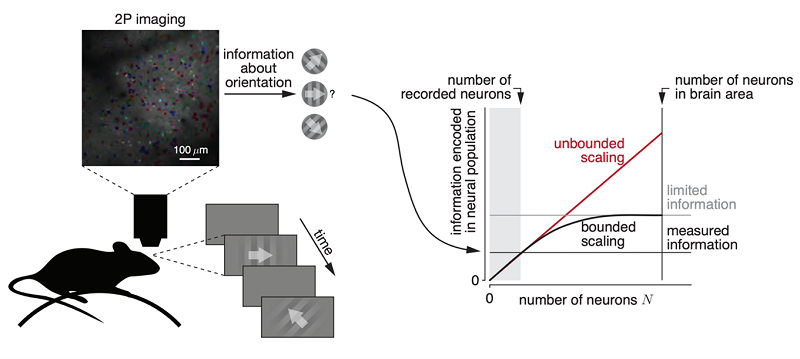By MohammadMehdi Kafashan, Anna Jaffe, Christopher Harvey, and Jan Drugowitsch
Our brains process sensory impressions, like an image that hits the back of our retina, by modulating the activity of large numbers of neurons in sensory cortices. These are regions of the outer layer of the brain dedicated to specific senses. How do neurons in other brain areas interpret this activity to process information about the outside world? In particular, how much information does this activity provide about the world, and how distributed is this information across the larger neural populations of sensory cortices?
Answering these questions leads to a better understanding of how much information actually enters the brain, as well as how the brain ought to be wired up to process it. Addressing them, however, is challenging, as – despite recent advances in recording techniques – we can still only record the activity from a small subset of neurons in these sensory cortices. It turns out, however, that we can use statistical regularities in the activity of these subsets to infer the desired properties of larger populations.
To test this approach, Anna Jaffe recorded hundreds of neurons in the visual cortex of mice who were observing patterns of different orientations. We in turn asked how much information the activity of these neurons provides about the patterns’ orientation. In principle, the more neurons we record from, the more information we can extract from their activity – but only up to the total amount of information that the recorded brain area contains about the world. Therefore, we expect information to saturate with increasing population size. Directly observing such a saturation is impossible with current recording techniques. However, we could already identify signatures of such saturation within the population sizes

We recorded hundreds of neurons of primary visual cortex (V1) of mice observing a sequence of drifting gratings, and estimated how much information the activity of these neurons contain about drift directions. We in turn asked how this information scales with the number of recorded neurons. Statistical signatures of this scaling suggest that information saturates, but does so in populations much larger than those we recorded from.
we recorded from. From this we could infer that about tens of thousands of neurons are required to convey most of the information. Furthermore, we found the information to be present in a highly distributed and redundant way. This means that other brain areas processing this sensory information only needed to ‘read out’ a small subset of these sensory neurons – it didn’t matter exactly which ones.
Overall, our work confirmed that information saturates in larger populations, and provided insight about redundancy of this information and how it is distributed in such populations.
This work is a collaboration with Selmaan Chettih (Harvard PiN) on the experimental side, and with Ramon Nugeira (Columbia), Iñigo Arandia-Romero (University of Zaragoza), and Rubén Moreno-Bote (Universitat Pompeu Fabra) on the theory side.
MohammadMehdi Kafashan is Instructor of Anesthesiology at Washington University School of Medicine in St. Louis,
Anna Jaffe is a Program in Neuroscience graduate student at Harvard Medical School,
Jan Drugowitsch is Assistant Professor of Neurobiology at Harvard Medical School,
Christopher Harvey is Associate Professor of Neurobiology at Harvard Medical School.
Learn more in the original research paper:
Scaling of sensory information in large neural populations shows signatures of information-limiting correlations.Kafashan, M., Jaffe, A. W., Chettih, S. N., Nogueira, R., Arandia-Romero, I., Harvey, C. D., Moreno-Bote, R., & Drugowitsch, J. (2021). Nature communications, 12(1), 473. https://doi.org/10.1038/s41467-020-20722-y
News Types: Community Stories
